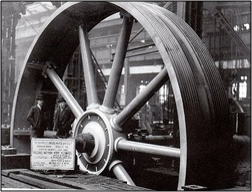What is Momentum?

We all know Aesop’s famous fable about the Tortoise and the Hare.
In short the story goes that Mr Tortoise and Mr Hare line up at the starting line for a running race. Mr Hare is very arrogant and self assured that he is going to beat Mr Tortoise that as the race starts he decides to lie down under a tree and take a nap. He is confident that there is no way that a tortoise is going to beat him in a running race, it’s a tortoise for goodness sake!
However, Mr Tortoise does not take a break and continues to slowly run the race one step at a time, slowly trudging along. When Mr Hare finally wakes up he is surprised to see that Mr Tortoise is very close to the finish line. No matter how fast he runs he can't catch up to him and Mr Tortoise crosses the finish line first, winning the race.
The moral of the story is that slow and steady versus fast and arrogant wins the race.
I have seen this same thing happen a number of times with the organisations I've been involved in. The leaders are confident and full of big ideas about massive events they want to host, the type of sponsors they want to attract, etc. and they hit the ground running. However, a year later nothing has happened, the organisation is falling apart or disbanded. The leaders tried to bite off more than what they could chew and tried to do too much too quickly.
Before I ever start on a big project I normally try to do something simple first; like try to get everyone to arrive at the same venue at the same time...Lets start at 8? No, lets' start at 9. Okay, we’ll make it 9, but everybody arrives at 10. I'm sure you know exactly what I'm talking about, it's like herding cats!
If you can't even get a team to accomplish something simple like that, how are you as the leader going to embark on massive and amazing projects?
I'm not saying you should not strive towards doing massive and amazing projects, but one should rather work towards building momentum in your organisation so that you can build towards these massive and amazing projects by going from one smaller project to the next, one project at a time, while slowly getting bigger and better.

The Fly Wheel Effect
Another analogue for this type of momentum comes from the book Good to Great by Jim Collins. Collin's made an analytical study of companies in America that went from being good companies to absolutely amazing companies. Through his methods he was able to identify the traits and characteristics that made these companies out perform their competition.
One of the traits he talks about in this book is the Fly Wheel Effect. You can see from the picture just how big and massive an industrial fly wheel is. Compare it in size to the men standing next to it and just try imagine how big and heavy the wheel must be.
Now imagine that your organisation is that stationary fly wheel and you have to make it turn.
Picture yourself standing there and you start to push. Can you picture the amount of effort it is taking you just to make it move? Yet you don't stop and you continue to push with all your might and eventually after an incredibly amount of effort you get it to move and after even more effort you get it to turn one complete rotation!
You continue to keep on pushing with almost as much effort and you get it to complete a second rotation and then another and another. However, with each successive rotation you realize that it is taking less and less effort than the previous one and before you know it the fly wheel is turning on its own with only the occasional push from you because of the momentum you have built up it is essentially running on its own.
This is the type of momentum that you need to build in your organisation and I'm going to show you how to achieve it!




